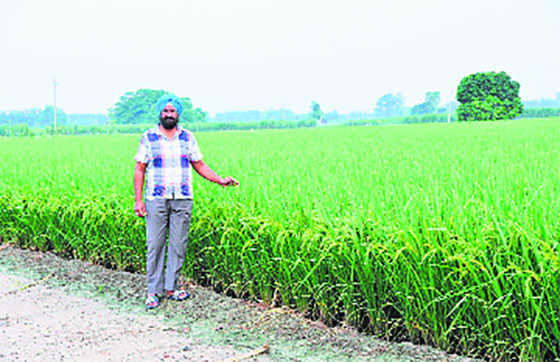
Progressive farmer Harwant Singh from Nawanshahr has not set crop residue on fire for the past two decades. Tribune Photo
Tribune News Service
Nawanshahr, September 14
Harwant Singh, a progressive farmer from Nawanshahr, has been setting a path-breaking trend in stubble management. Besides, he has not set crop residue on fire for the past two decades, emerging as a role model for others.
Harwant said in 1994, he had decided to shun the practice of stubble burning as it was harmful for nature, insects, environment and human beings. He cultivates his land in Saroya of the Balchaur area.
Divulging details, Harwant said, “I use paddy stubble and residues of the sugarcane crop for mulching, which save irrigation water, diesel and power. Likewise, this technique has also been helping control weeds. Moreover, these initiatives prove to be helpful in keep the environment safe.”
He added that using stubble as mulching was a natural production of vermiculture. “The natural phenomena of vermiculture help maintain the soil health. Verms go to deep in the earth by one meter, which help recharge of water and also increase the root zone of the crop.”
A state awardee in horticulture and former member of the Government of India’s Commission on Cost and Price on the Sugarcane Policy, Harwant said these days, there were many mechanised equipment viz. rotavator, happy seeder, zero till drill, baler and mould board (MB) plough to curb stubble burning, but as per his experience, MB plough and baler were more effective.
Moreover, biomass-based power generation plants need bales as a raw material, he said.
Citing the rainfed areas of other parts of the country, including Yamunanagar and Uttarakhand’s Tarai, he said farmers of these areas had adopted the mulching technique to overcome scarcity of rainwater. Similarly, Maharashtra farmers used the mulching technique up to 80 per cent to save water, he added.
“If a farmer is not in a position to procure these costly mechanised operations, there is another simple way to use stubble as pesticide in the fields. A farmer can gather stubble at one place and spray two to three per cent urea mixture or urine of animals on it that will convert stubble into a fertile homemade pesticide in 45 days,” Harwant said.



























